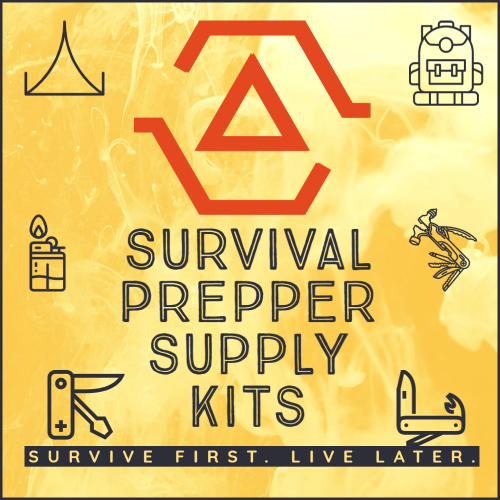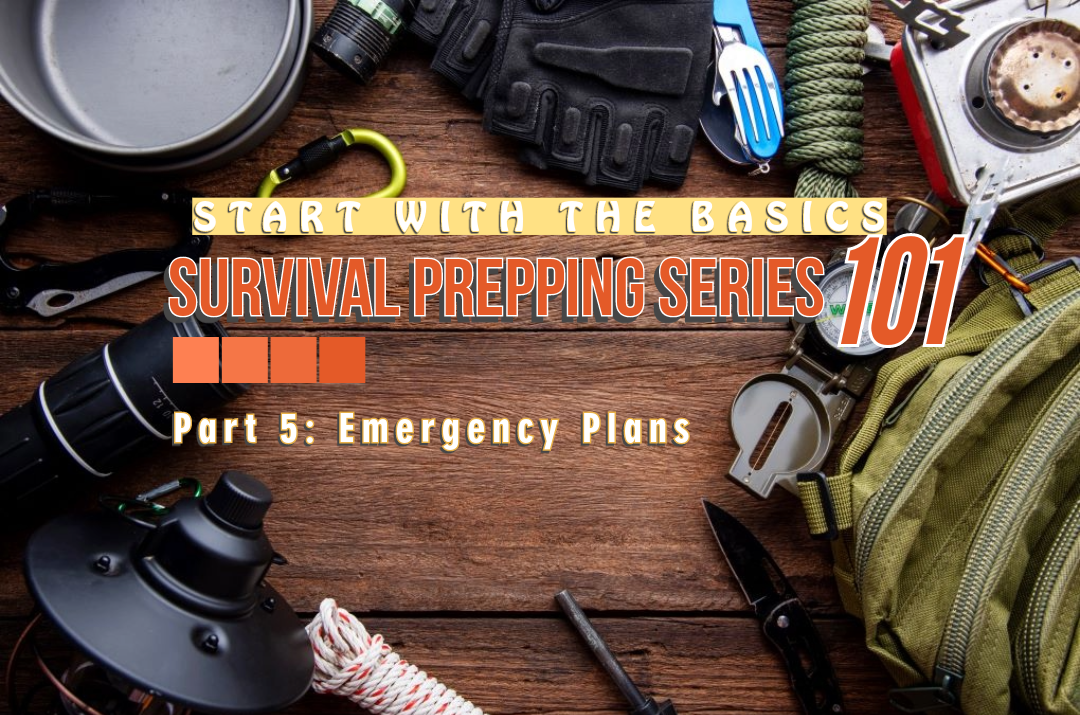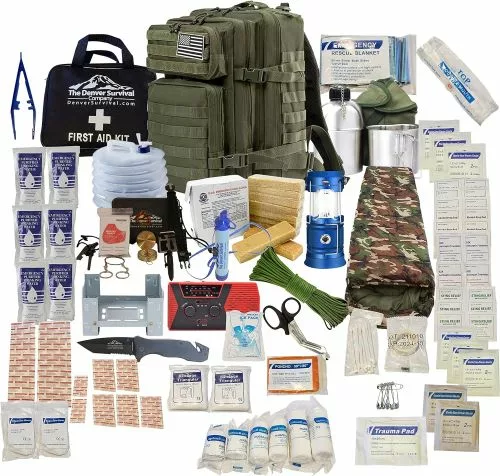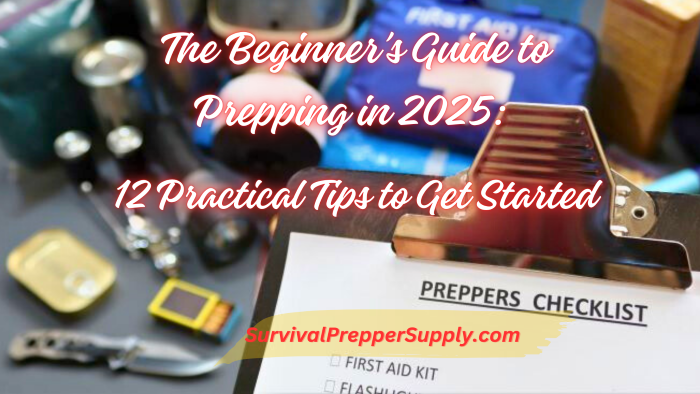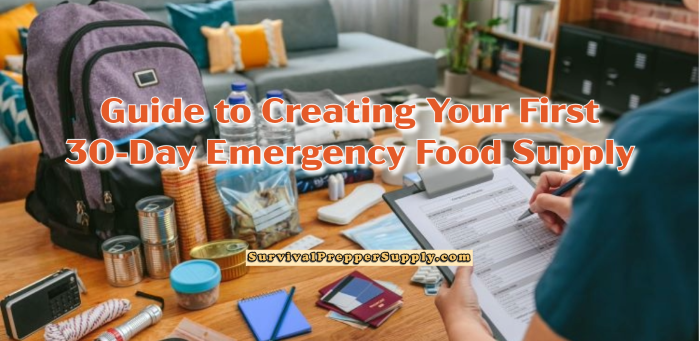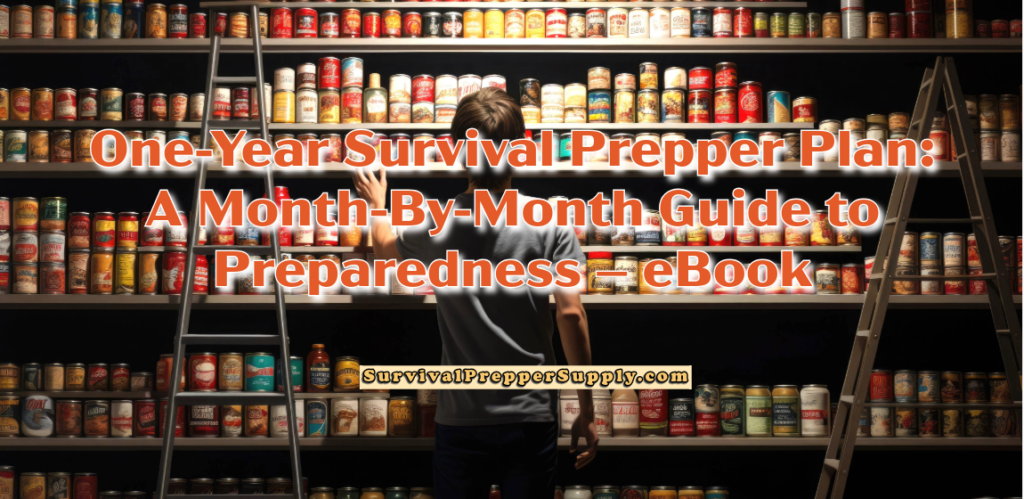Prepare for a 72-Hour Emergency in Your Survival Prepping Plans
A genuine survival situation will persist for three days in most individuals’ lives. While there have been instances throughout history where such situations have endured for longer periods, a survivalist should prepare for at least three days, during which they will be without electrical power and access to various convenience items. Survivalists should have the necessary equipment and supplies to bug out.
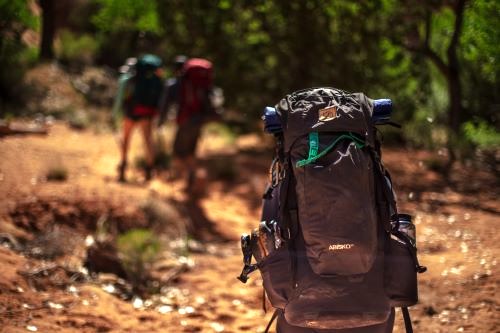
A financial safety net covering three months of expenses in a crisis is similar to preparing for a 72-hour emergency. It’s a short-term solution to help you survive a difficult period. Are you prepared for a disaster with a backpack filled with essential supplies you assembled yourself, or have you bought a complete survival kit?
It is better to stay home whenever possible than relocate to another area. Even with proper equipment and experience, three days in the wilderness can be grueling.
Related – Survival Prepping 101: Your Unique Action Plan
Please note that this post contains affiliate links, meaning I will get a small commission for qualifying purchases at no extra cost to the buyer.
The rationale for the 72-hour threshold as a bare minimum is that it will take roughly this long for emergency officials or government agencies to arrive and provide aid to all those in need.
Here are
2023 Model 72-Hour Premium 3-Day Bug Out Bag Survival Prepper Emergency Kit
✅ 45 Liter Highly Durable Tactical MOLLE Backpack
✅ 3 Days of Food and Water with 5 Year Shelf Life
✅ 2000mah Solar Radio and Charger AM/FM/NOAA
✅ Extra Comfortable Sleeping Bag and Compresses Easily.
✅ 1 Liter Canteen and Stove.
✅ 5 Liter Water Cistern
✅ Comprehensive First Aid Kit
✅ Poncho, Emergency Blanket, Compass, LED Solar Lantern, Etc.
Complete 72-Hour Bug Out Bag Emergency Survival Kit for Family.
.Designed and hand-picked by survivalists, experts, and veterans. Including everything you and your loved ones need to survive for 72 hours. The most comprehensive and ULTIMATE emergency kit to prepare you for any emergency or disaster.
✅ Water & Food – Water Filtration Tablets. 24 Packs of 125ML Emergency Drinking Water and 2 Packs of 3600-calorie emergency Food Bar with a 5-Year Shelf Life.
✅ First Aid Essentials – CAT Tourniquet for Bleeding Control. 200 Pieces of comprehensive medical supplies.
✅ Premium Protection/ Survival Gear and Tools – 3 in 1 Hand-Crank flashlight with radio/phone charger, emergency shelter, thermal blankets, poncho, goggles, gloves, CAT tourniquets, camping knife, compass, glow sticks, etc.
✅ Heavy Duty Tactical Military-Spec Molle Backpack – Easy to organize and store with four main compartments of the bag and many inner pockets.
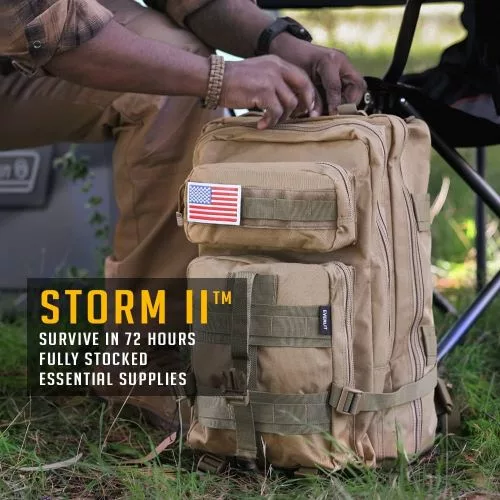
Prepares you for any emergency or disaster. Heavy Duty Tactical Military-Spec Molle Backpack. Easy to organize and store with four main compartments of the bag and many inner pockets.
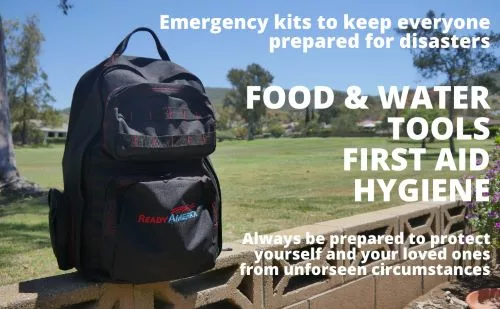
2-Person 3-Day Backpack, First Aid Kit, Survival Blanket, Power Station, Emergency Food, Portable Disaster Preparedness Go-Bag.
Stay prepared for emergencies everywhere you go. Ready America emergency survival kits sustain two people for three days (72 hours). Basic essential emergency supplies recommended by the American Red Cross, as well as a hygiene kit, masks, thermometer, survival blankets, and ponchos
✅ 33 Piece First Aid Kit: The essentials for minor injuries like bandages and wound cleaning solution. Take care of medical emergencies with easy-to-use supplies. Great for a car emergency kit or boat accessories.
✅ U.S. Coast Guard-approved food and water pouches with a 5-year shelf life, water purification tablets, and a BPA-free water bottle
✅ Includes a stainless steel multi-function pocket Tool with screwdriver, pliers and knife functions, a 4-function power station with radio, charger, flashlight, siren capabilities, etc.
During this initial phase, you will most likely be confused and frantic, searching for stability during chaos. Ensuring you have a plan to meet all your basic needs, such as food and water, for the first three days after a disaster strikes will help ensure a more secure future.
Read – 10 Easy Ways To Learn Bugging Out Lessons From Your First Backpacking Trip
An emergency kit prepared in advance can provide a sense of calm during natural disasters and other emergencies. This is especially important if you live in a region that experiences frequent events such as hurricanes, floods, wildfires, or power failures.
Assess Your 72-Hour Survival Risk
It’s crucial to consider various circumstances when contemplating overall survival preparedness. Nevertheless, when considering the potential risks in your immediate surroundings, you should prioritize the most likely possibilities.
For instance, if you’re located in North Texas, Oklahoma, or any place in Tornado Alley, you’ll need to prepare for a possible tornado. Similarly, people on the East Coast, South Texas, and even Florida must prepare for hurricane seasons and floods. Wildfires are also an issue in Florida, but they’re becoming widespread. Florida also has crazy sinkholes but not so many earthquakes.
Read This Book – 53 Essential Bug Out Bag Supplies: How to Build a Suburban “Go Bag” You Can Rely Upon
Preparing for severe snowstorms and a power grid failure in areas prone to harsh winter weather, such as in the northeast, is necessary. However, other regions may face the risk of wildfires, which could swiftly traverse the area and put people in danger.
The location where you live will significantly impact the way you prepare for the three days. For instance, if you live in a region prone to earthquakes, you must take specific measures. On the other hand, if you have to deal with diverse weather conditions throughout the year, you must adjust your preparation plan accordingly.
Related – Bushcraft – The 5 Most Important Survival Tips for Beginners
For instance, tornadoes generally occur during a specific period, just like hurricanes and wildfires. The precautions you need to take may vary depending on the season. However, some occurrences may occur in your region that are not bound by any specific schedule.
Living near a railroad track or a manufacturing facility might expose you to chemical spills or other dangerous circumstances. When I was young, we lived on 30 acres close to a railroad track. I used to have scary, vivid dreams of the train jumping the track and coming toward me.
If you reside in Texas and are conscious that their power grid is prone to failure, you may want to be prepared for a potential power outage during intense heat or extreme cold periods.
You may reside in a region where public disturbances are common, such as rioting, arson, roadblocks, and violent outbursts. It’s also essential to prepare for such temporary circumstances.
Tools to Help You Succeed
While there are several fundamental requirements you should have available during an emergency lasting up to three days – including food, water, and a safe location, you may need to gather additional, more specific materials based on your individual risk evaluation.
Related – What You Need for Your Survival Prepper Bugout Bag
For instance, if you live in a floodplain, you may need to purchase materials to prevent floodwaters from reaching your home.
One of the essential things you’ll need in a crisis is clean water. Short-term emergencies may pose risks to your existing water supply, and you’ll be advised against drinking tap water. Make sure to stock up on water purifiers and emergency drinking water you can access immediately.
It’s also crucial to have food that’s simple to consume if you don’t have access to electrical power. For instance, if it storms and you don’t know how to light a fire for cooking, or if there’s no electricity, you’ll need pre-cooked meals that you can open and consume without heating.
Investing in a powerful generator to sustain you and your family may be advantageous until the power is reinstated. This will give you peace of mind.
Even if you’re at home, you might still require additional provisions in the event of a prolonged stay, such as during a severe storm. For instance, during the winter power outage in Texas, individuals who had erected tents within their homes could stay warm due to the warmth of their bodies inside an insulated environment. In contrast, those without a home structure experienced temperature drops to 30 degrees.
Related – Grab-and-Run Emergency Kits for Swift Evacuation and Preparedness
It’s also important to have basic first-aid equipment on hand. You may need to provide aid for a scrape or a broken bone. The necessary medical equipment should be present to help an individual survive an emergency until assistance arrives.
You must also have the means to communicate with emergency responders. You want to let them know your location, the condition of everyone, and any other relevant information for them to take appropriate action.
It’s important to carry cash in smaller denominations. In an emergency, you may not be able to use your credit or debit card, and some stores might not have enough change for large bills.
Learning How to Survive
Just like there are specific tools and materials you might need for a particular survival scenario, you may also need to have specialized knowledge for certain situations. For instance, knowing how to prepare your home for a potentially dangerous wildfire or flood could be beneficial.
Alternatively, if you’re in a civil unrest scenario, you may need to receive instruction on securing and protecting your home, belongings, and family. This might involve signing up for courses focused on surviving in such situations and practicing self-defense.
Related – Smart Survival Food Storage for Emergency Preparedness: Expert Advice, Part I
Assigning specific tasks to each family member can be beneficial during emergencies. Ensure that all individuals are aware of their duties and execute them efficiently. Regularly practicing these actions ensures that they will instinctively respond during crises rather than panic while trying to remember their responsibilities.
In a family evacuation, it is important to practice meeting up at a specific location. This will ensure family members scattered due to work-related, educational, or home commitments can reunite quickly.
When preparing for at least 72 hours, your aim is to help alleviate the stress and anxiety that many others will experience during that time. By investing some time and spending only a little money on supplies, you will have equipped yourself to deal with whatever comes your way at any moment.
Related – Why Start Your Day With Gratitude and Positive Thinking?
Over time, as your supply of resources expands, you won’t have to fret about whether you’ll have enough for three days. Instead, you will have sufficient for three whole weeks, three months, three years, and beyond. Additionally, you will guard this supply closely, ensuring no one else is left without a backup plan.
Read next – Survival Prepping 101 Series Part 6: Start Gathering Your Medical Supplies.
I’m the daughter of 2 original survivalists who moved from the north to sunny Florida. My mother, along with her parents, bought 30 mostly uncleared acres in 1938. The first home was made of pecky-cypress and built by a house-raising. My mother raised 10,000 chickens.
My divorced mother met and married my father in 1948. From pine trees on our property, he hand-built a log cabin. He also built a tarpaper-lined 65’x45′ pool with duck pond overflow. We had an artesian well for our water and powering our hand-built waterwheel for the pool. He built a substantial cantilevered roof workshop with a car pit in the massive cement floor.
Since my early teens, I have read a ton of books about survival, prepping, the bomb, an apocalypse, homestead living, and SHTF situations. As an adult, I continue to read sci-fi, survival prepping, and science. I practice a prepper lifestyle albeit a bit modified, read a lot, buy a lot, pack/store a lot of anything survival related.
Read my About Me post for more details on our self-sufficient living. I lived there until I went to college in 1968.
My SurvivalPrepperSupply.com blog strives to educate individuals on coping with natural and human-caused disasters using article posts about preparing for emergencies.
